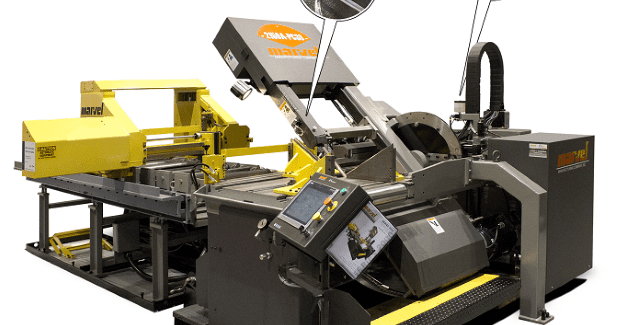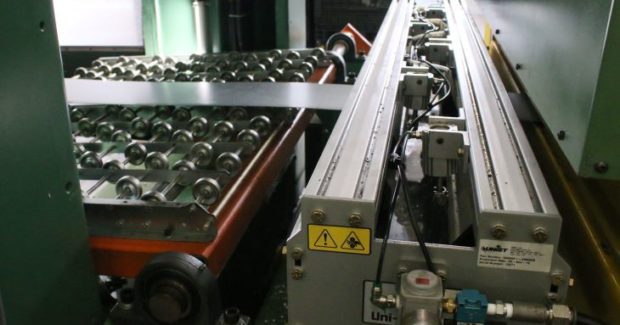Metalworking Fluids: Less Is More
A targeted and calibrated approach to lubrication ensures fluids arrive exactly where they need to be, when they need to be there, and in the correct amount, ensuring metalworkers are confident in their ability to make good parts.
Posted: November 3, 2021
SMOOTH OPERATIONS
By Tim Bangma
Fabricating and metalworking processes involving the bending and cutting of metals frequently require the application of metalworking fluids. These fluids provide lubricity and remove heat. Over the years, there have been several commonly utilized application techniques. Today, it is apparent that accurate and repeatable dispensing can pay dividends — affirming the adage that sometimes less is more.
A REAL-WORLD ANALOGY
An analogy can be drawn between the application of metalworking fluids and irrigation. One way to water your garden is to go to the hardware store, purchase a sprinkler, connect the garden hose, turn on the faucet, and let the sprinkler do its thing. This method will probably get water to all the plants in your garden and will work as long as you remember to turn the faucet on and off at the right times. If you forget to water for a few days, your plants might start to wilt and if you leave the sprinkler on all night, you will have wasted water. While watering, you are unintentionally over-spraying onto other parts of your yard that don’t really need watering. With this method, excess water runs down the driveway, and this method assumes all plants require the same amount of water.
A targeted approach to irrigation is to install a drip irrigation system with a timer for your garden. Each plant could have its own drip nozzle calibrated to provide that plant the right amount of water. An automatic timer can be installed to water the garden for several minutes a few times a day for consistent soil moisture. Every plant receives the right amount of water and the total amount of water consumed by the garden is much less. The drip system takes a little bit more effort to install but is much more efficient.
METALWORKING PROCESSES
Several fabricating and metalworking processes stand to benefit from a targeted and calibrated approach to lubrication. The cost of using a metalworking fluid is often underestimated as only the cost of the fluid itself. The true cost can end up being a multiple of eight-to-15 times that cost. Fluid handling, preparation, clean up, filtering, parts washing, and disposal all add up, not to mention any additional downtime caused by these activities. Unist’s approach to fluid application has always been to provide solutions that get the fluid exactly where it needs to be, when it needs to be there, and in the correct amount. This gives metalworkers confidence in their lubrication and ability to make good parts even if they no longer visibly see metalworking fluid splashing.
TWO APPLICATION EXAMPLES
Band Sawing
Traditionally, band saws have been equipped with flood coolant delivery systems. These systems flood the blade with coolant and a series of collection guards and pans divert it back to the sump. This provides a cooling effect for the cutting process; however, it leads to a big mess. Coolant can run through and out the end of tube stock, splash off the blade, and drip off parts coming off the saw. Without proper maintenance, coolant in sump tanks can begin to smell and eventually will need to be disposed of.
A more targeted approach to lubrication on band saws is to install a Minimum Quantity Lubrication (MQL) system. A Saw Blade Lube System™ from Unist applies a small amount of a high-quality lubricant directly to the blade before entering the cut. Nozzles are positioned to apply the lubricant to the teeth and into the gullet. Guide nozzles can also be used to lubricate the sides of the blade and the guides themselves. A variety of nozzles are available for varying blade widths.
This calibrated method of lubrication allows band saw operators to achieve better cut quality and blade life when using a high-quality, MQL lubricant such as Coolube®. Benefits in cleanliness are also quickly realized leading to a short return on investment.
Band Sawing
Flood Coolant
Coolant spills on floor
Simple on/off control
More fluid consumed
High total cost of ownership
Same coolant for every cutting job
MQL Saw Blade Lube
Targeted delivery to blade and guides
Adjustable delivery
Ounces per shift consumed
Lower operating costs
Rates adjustable for each cut
Metal Stamping
Applying metal working fluid in metal stamping and forming processes is critical to ensuring consistent part quality and long die life. Traditional approaches to applying lubricant with cheap nozzles usually lead to over application in some areas and dry stock in others. They also deposit a large amount of fluid in the press pit. Human nature tends to cause the belief that more is better so operators crank up pressure and turn valves wide open. The assumption is made that because fluid is dripping on the floor, it must be on the part, right?
If we again apply our target drip irrigation example to applying metal stamping fluids, the goal is to apply lubricant evenly, consistently, and in the right places. A Uni-Roller® roll coater will apply a consistent, thin film of lubricant to both sides of the stock providing even coverage. Over-spray is eliminated with a roller applicator and the press area stays clean. Supplemental spray nozzles can be added for aggressive form tooling but should only be used as required. With a programmable controller, such as the Unist SmartFlow®, the amount of lubricant can easily be configured for each individual job and total fluid consumption can be tracked.
A metal forming lubrication system of this type regularly provides a 50-to-90 percent reduction in fluid consumption. Coupled with the savings realized from reduced cleaning and improved safety, less is indeed more and typically leads to a 12-to-18-month ROI.
Metal Stamping
Traditional Application
Coolant ends up on floor
Manually adjusted nozzles
More fluid consumed
High total cost of ownership
Same coolant for every job
Controlled Application
Targeted delivery to stock and critical areas
Programmable fluid delivery
40-to-80% reduction in usage
Cost savings beyond just fluid savings
Calibrated delivery for each job
WHAT IS RIGHT FOR YOU
When looking to improve your manufacturing process, don’t overlook the importance of fluid delivery systems. By understanding all the increased housekeeping and maintenance costs associated with your current fluid delivery system, a change can likely be easily justified. Items to consider for a new system:
- The level of control required to accommodate the variety of parts made on the line
- The quality of the fluid you are using – using less fluid more efficiently can justify a better fluid
- The level of feedback you want to ensure the system is operating properly
- The type of operator adjustments you want to allow or disable
- The data you want to gather from your application system
Virtually any metal cutting, machining, or forming process can benefit from a better lubricant delivery system. Manual machining, sawing, and CNC machining can all be successful with MQL. Stamping, forming, deep drawing, roll forming, progressive dies, blank forming, etc., can all benefit from a programmable fluid controller and a better applicator. By improving the process, you can truly see that less is more.
Tim Bangma is the product manager for Unist Inc. Email tbangma@unist.com.












